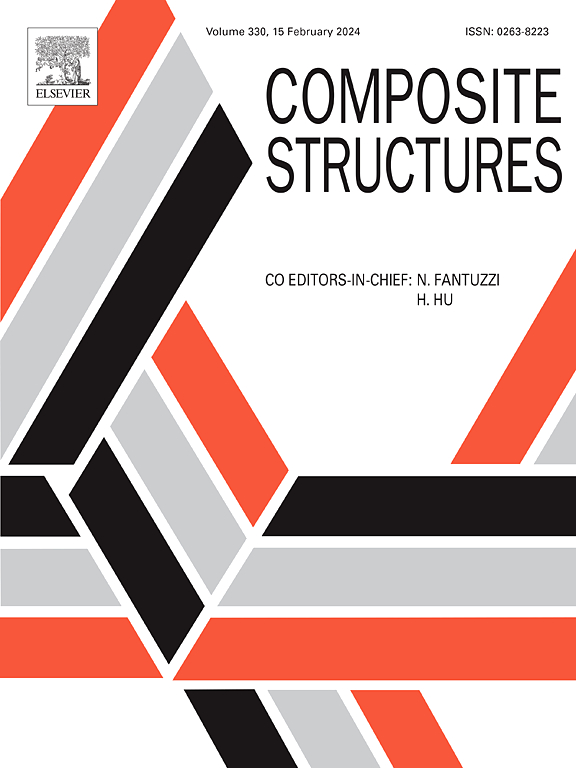Evolution of microstructure and mechanical properties of directional lamellar Ti3Si(Al)C2/Al composites via Al doping and electron beam melting infiltration
IF 6.3
2区 材料科学
Q1 MATERIALS SCIENCE, COMPOSITES
引用次数: 0
Abstract
Directional lamellar Ti3Si(Al)C2/Al composites were fabricated by infiltration of molten Al in freeze casted Ti3Si(Al)C2 preforms. Infiltration by electron beam melting favored the breaking of oxide film on molten Al and reduction of the infiltration time (40 s) to control interface reactions. Doping Al in Ti3SiC2 preforms facilitated reactive wetting with Al matrix, which further halved the infiltration time and formed a compact interface. The composites consisted of Ti3Si(Al)C2, Al, TiAl3, and TiC, and in-situ formed TiAl3 improved the interface bonding. The internal diffusion of matrix Al led to TiAl3 formation along the lamellar direction, while the external diffusion of Ti damaged the lamellar structure of Ti3Si(Al)C2. Al doping promoted Ti3SiC2 decomposition and Ti external diffusion, causing a reduction of Ti3SiC2 volume fraction from 43 % to 15 % and tortuosity increase from 1.6 to 8.1. The composites fabricated via electron beam melting exhibited an average Young’s modulus of 95 GPa and hardness of 3.7 GPa, with these values increasing as the Al-doped content rose.
While the maximum yield strength in compression of the composites, 370 MPa, was achieved at an Al doping content of 0.12, which was due to the contributions of the lamellar structure and TiAl3 formation.
Al掺杂和电子束熔渗对Ti3Si(Al)C2/Al定向层状复合材料显微组织和力学性能的影响
在冷冻铸造Ti3Si(Al)C2预铸坯中注入熔融Al,制备了Ti3Si(Al)C2/Al定向层状复合材料。电子束熔渗有利于铝液氧化膜的破裂,降低了渗渗时间(40 s),从而控制界面反应。在Ti3SiC2预成型中掺入Al有利于与Al基体的反应性润湿,使渗透时间进一步缩短一半,并形成致密的界面。复合材料由Ti3Si(Al)C2、Al、TiAl3和TiC组成,原位形成的TiAl3促进了界面结合。基体Al的内部扩散导致TiAl3沿片层方向形成,而基体Ti的外部扩散破坏了Ti3Si(Al)C2的片层结构。Al的掺入促进了Ti3SiC2的分解和Ti的外扩散,使Ti3SiC2的体积分数从43%降低到15%,扭曲度从1.6提高到8.1。通过电子束熔化制备的复合材料的杨氏模量为95 GPa,硬度为3.7 GPa,随着al掺杂量的增加,这些数值逐渐增加。当Al掺杂量为0.12时,复合材料的最大屈服强度为370 MPa,这是由于层状结构和TiAl3的形成。
本文章由计算机程序翻译,如有差异,请以英文原文为准。
求助全文
约1分钟内获得全文
求助全文
来源期刊

Composite Structures
工程技术-材料科学:复合
CiteScore
12.00
自引率
12.70%
发文量
1246
审稿时长
78 days
期刊介绍:
The past few decades have seen outstanding advances in the use of composite materials in structural applications. There can be little doubt that, within engineering circles, composites have revolutionised traditional design concepts and made possible an unparalleled range of new and exciting possibilities as viable materials for construction. Composite Structures, an International Journal, disseminates knowledge between users, manufacturers, designers and researchers involved in structures or structural components manufactured using composite materials.
The journal publishes papers which contribute to knowledge in the use of composite materials in engineering structures. Papers deal with design, research and development studies, experimental investigations, theoretical analysis and fabrication techniques relevant to the application of composites in load-bearing components for assemblies, ranging from individual components such as plates and shells to complete composite structures.
 求助内容:
求助内容: 应助结果提醒方式:
应助结果提醒方式:


